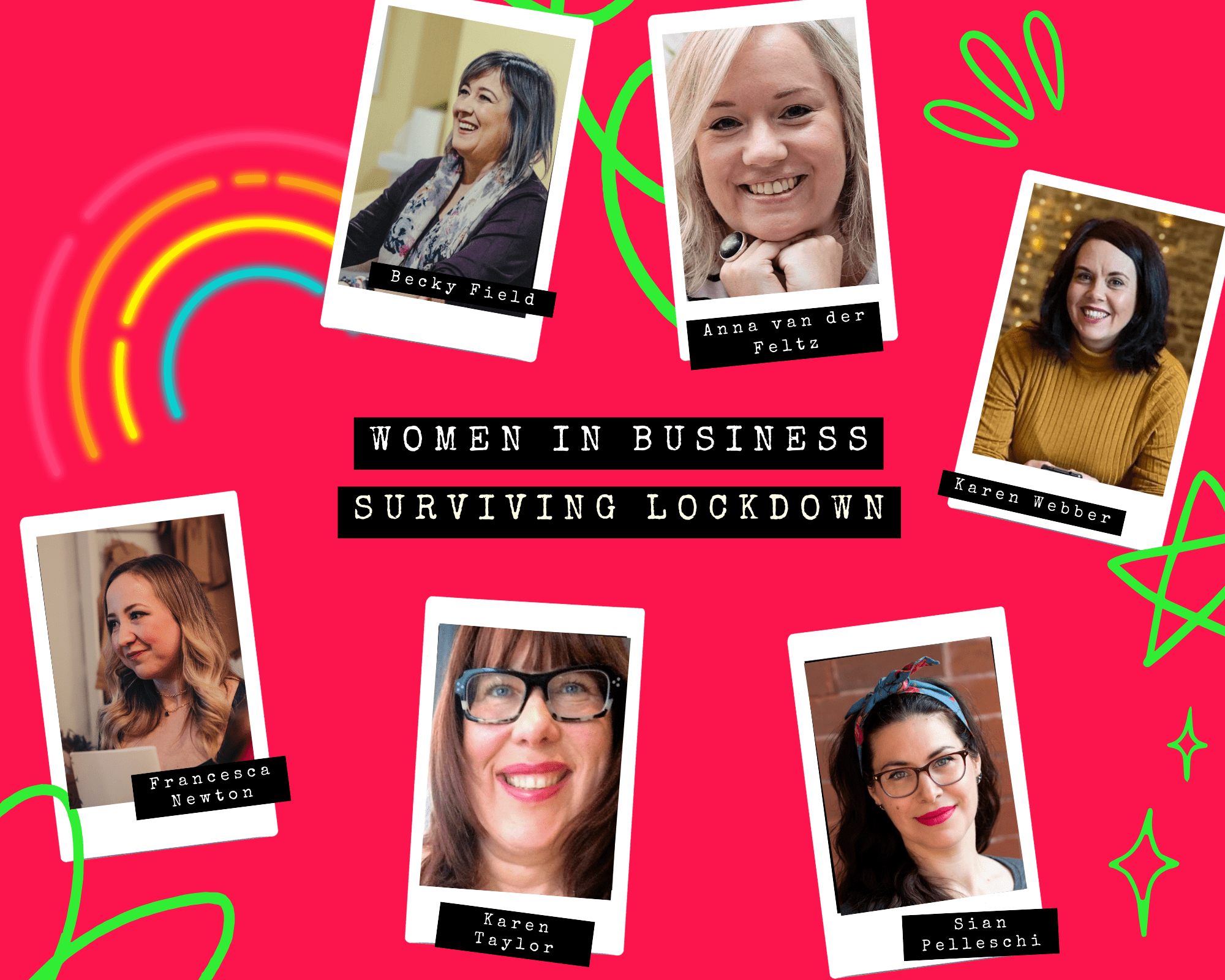
Surviving lockdown: six women in business share their top tips
If you’re a small business owner or solopreneur, it’s likely you’ve been affected by the COVID-19 pandemic. Haven’t we all? As a freelance copywriter, my work all but dried up overnight, leaving me in a startlingly bleak position.
A wife, mum and small business owner, I found myself in some sort of limbo: copywriting is what feeds the ‘me’ behind all the other roles I fill day-to-day, and I’ve found the current situation has brought on a kind of identity crisis coupled with existential dread.
After almost a month of uncertainty, I decided to reach out to some of the women in business I respect most. These small business owners have all been affected by the current situation, but together, we’re supporting each other in making the most of lockdown by sharing our ideas and learning how to become more resourceful.
There are ways of focusing your mind, honing your marketing strategy and adjusting your working practices to promote productivity – both during lockdown and in periods of downtime in the future. Here are a selection of expert tips you can put into practice right now.
Refine your messaging
by Francesca Newton, Copywriter, EVE Writing Services
Now is prime time to reassess your priorities and make sure you’re targeting your ideal client. Use quiet periods to assess the words you use to market yourself and ensure they resonate with the audience you want to work with.
Define your audience segments – Has the pandemic concentrated your mind? I for one have used the last month to create a really clear picture of my audience and how I can serve each segment through different services – something I’d thought about previously but never actioned.
Get creative – To ensure you’re prepared for future periods of downtime, come up with an action plan for ways to take services online or remote. Creating virtual workshops, hosting webinars or publishing paid-for eBooks are all ways to generate income when work is slow.
Hone your About info – Rewrite your About info to account for your audience’s pain points, reassure them of your expertise and create a compelling case for working with you. What makes you different? Why should a client choose you? Make sure your integrity shines through.
Stop social media comparison-itis
by Becky Field, Coach, Westfield Coaching
When you’re a small business with a social media presence you can literally waste hours scrolling and getting nowhere. It’s said that ‘comparison is the thief of joy’ and believe me, it is ruthless.
In these vulnerable times, it’s so easy to go down a rabbit hole of social media. To bring comparison-itis to an abrupt stop and stay focused on our own lane, here are some top tips that I encourage clients to follow:
Close the other lanes and unfollow pages – You can follow them again when you get stronger but to stop comparing, you need to stop watching.
Leave races – If you are lined up for 100 metres but are a long distance runner, you are in the wrong race. Leave Facebook groups that do not bring you a) joy or b) business. Walk away.
Look at your own path and plan your route – Your time is better spent focusing on YOUR business, YOUR ideal clients and YOUR processes. What do you need to do RIGHT NOW to help you with your confidence? Just taking one productive step forward will help you.
Find out more about moving from panic to productivity here.
Make your home office more conducive to work
by Sian Pelleschi, Professional Declutterer and Organiser, Sorted!
In times like these, when we’re in our own environment for the majority of each day, it’s really important to make sure your surroundings are working for you.
If you were working in an office with others previously, or perhaps had the kitchen table to yourself during the week, you might now find yourself having to create a working environment that keeps you productive.
Here’s what to consider when creating a conducive working environment in your home office.
Lighting – Natural light is best for working during the day, keeping your serotonin levels steady and helping you stay alert and focused. If you’re a late night worker, invest in a daylight lamp to keep you going.
Desk – Position your desk away from draughty doorways and windows, and close enough to your filing system or storage units so you can easily reach them when you need to get out a new file or put something away. Keep the bare minimum close at hand and store the rest away, but make sure you create a filing system on your desk if you handle a lot of paperwork.
Storage – Choose storage solutions that fit your files, boxes and style. Be clear on what you need before spending on storage items, otherwise you could find that they don’t fit the shelving properly or that you don’t have enough space.
If you don’t have a dedicated work space for temporary working, try to create an area in a room that can be shut off from the rest of the house, following the rules above rather than using the kitchen table. For more top tips about designing and styling your home office, check out this video.
Become a cheerleader
by Karen Taylor, Business Mentor, Your Business Mentor
During these ‘stay home, stay safe’ times, cheerleading is particularly important. Cheerleading is about businesses helping each other as much as we can.
I meet lots of small business owners who are fantastic at what they do but aren’t so good at pushing themselves forward. As such, they are ‘hiding their light under a bushel’, which isn’t ideal for growing a business.
Whether your work is on hold or continuing as normal, we can all help each other ensure our businesses are sustainable for the future through cheerleading.
Social media – Like, comment and share each other’s posts. Even the small things help; you never know who might see something they need.
Recommendations and referrals – If there’s a business owner who you think is fantastic at what they do, tell other people. When I know someone has a need for a service or product, I often recommend small business owners who are excellent at what they do, which regularly results in sales for the recommended business.
Case studies – If you work with or use other businesses, consider writing a case study documenting how you worked together, the results and the benefits. As a business mentor, I work with lots of small business owners and always make a point of posting a case study. This simultaneously reminds clients of their progress, helps others see what’s possible and advertises BOTH of our businesses.
So, let’s do all we can to help other small business owners – be a cheerleader and spread the love!
Create a brand moodboard
by Anna van der Feltz, Graphic Designer and Branding Consultant, Anna VDF Creative
Creating a moodboard is a great exercise to do during downtime, and it’s fun, too!
1) Firstly, create one board of your current marketing materials. How do they make you feel? Are they consistent? Do you use the same language across all touchpoints? Are the fonts and colours you use the same? Are the images similar?
2) Start building another mood board of how you’d like your brand to be or what your dream brand looks like. A Pinterest board is the best way to do this. Look at colours, fonts, imagery, photography, illustrations, packaging and magazines, consider famous people or celebrities you like, interiors, style of writing, layouts, packaging – basically anything that you are drawn to. What other brands or products do you like? Add the things you like about them to your board.
3) Now compare the two boards. What do you see? Can you inject some of your dream brand board into your current brand board?
This is just a starting point; hopefully it’ll will help you find some clarity on where you want your brand to be and give you some ideas of how you can start implementing changes to your current branding.
Reassess your marketing
by Karen Webber, Owner, Goodness Marketing
The global pandemic has put some distance between us and the way in which we usually run our small businesses. It’s a stressful, uncertain time, but also a chance to look at your business with fresh eyes.
There are three things I recommend small business owners do to prepare for the future – regardless of what that might look like.
Articulate your purpose – Why do you do what you do? Your values and beliefs, packaged in a clearly articulated purpose statement will help guide your business direction and ease marketing decision making.
Be clear about your target audience – Would you rather have 1,000 people shrug at your marketing messages or have 100 get excited enough to buy from you? To deliver the right message to those 100, you need to know exactly who they are: their challenges and how you can solve them.
Assess your marketing – Now, look at all your existing marketing – website, social media, flyers, the works – with your purpose and audience in mind. What can be improved? Make a list and schedule time every day to chip away at it!
Steps to success
There’s lots to go at here; start small with one objective at a time. Even the smallest steps add up – you might be surprised at what you’ve achieved when lockdown comes to an end.
In the meantime, you’ll find plenty more tips and support via our websites and social media accounts. Feel free to get in touch with any of us directly and let’s support each other in staying strong – better times are ahead.


